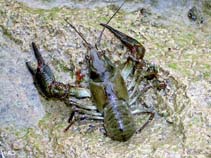Astacus astacus (Linnaeus, 1758)
Noble crayfish
Classification / Names ชื่อสามัญ | ชื่อพ้อง | CoL | ITIS | WoRMS
Malacostraca | Decapoda | Astacidae
Environment: milieu / climate zone / ระดับความลึก / distribution range นิเวศวิทยา
; น้ำจืด. Temperate
Distribution ประเทศต่างๆ | พื้นที่จำแนกตาม FAO | ระบบนิเวศหลายระบบ | การปรากฏขึ้น,การเกิดขึ้น,พบ | การแนะนำ
Europe inland waters: northern and eastern Europe, including portions of France eastward to countries of the Russian Commonwealth and southern Scandinavia southward. Absent from the Italian and Balkan Peninsulas. Introduced to various parts of Europe, Western Asia and North Africa.
Length at first maturity / ขนาด / Weight / Age
วัยเจริญพันธุ์: Lm ? range ? - ? cm Max length : 25.0 cm TL เพศผู้/กระเทย; (อ้างอิง 127977)
Short description สัณฐานวิทยา
Life cycle and mating behavior วัยเจริญพันธุ์ | การสืบพันธุ์ | การวางไข่ | Eggs | ความดกของไข่ | Larvae
Main reference
อ้างอิง | ผู้ประสานงาน | ผู้ร่วมมือ
Hildyard, A. and M. Cavendish 2001 Endangered Wildlife and Plants of the World. Marshall Cavendish Corporation, NY, USA. 1872 p. (อ้างอิง 80788)
IUCN Red List Status
(อ้างอิง 130435: Version 2025-1)
CITES status (อ้างอิง 108899)
CMS (อ้างอิง 116361)
Threat to humans
Human uses
การประมง: การค้า; การเพาะเลี้ยงสัตว์น้ำ: การทดลอง
FAO - การเพาะเลี้ยงสัตว์น้ำ: production; การประมง: landings | FishSource | ทะเลรอบๆเรา
เครื่องมือ
ข้อมูลเพิ่มเติม
Max. ages / sizes
Length-weight rel.
Length-length rel.
Length-frequencies
Mass conversion
อุดมสมบรูณ์
แหล่งที่มาจากอินเตอร์เน็ต
BHL | BOLD Systems | CISTI | DiscoverLife | FAO(การประมง: ; publication : search) | Fishipedia | GenBank (genome, nucleotide) | GloBI | Gomexsi | Google Books | Google Scholar | Google | PubMed | แผนภูมิชีวิตแบบต้นไม้ | Wikipedia (Go, ค้นหา) | บันทึกทางด้านสัตววิทยา



